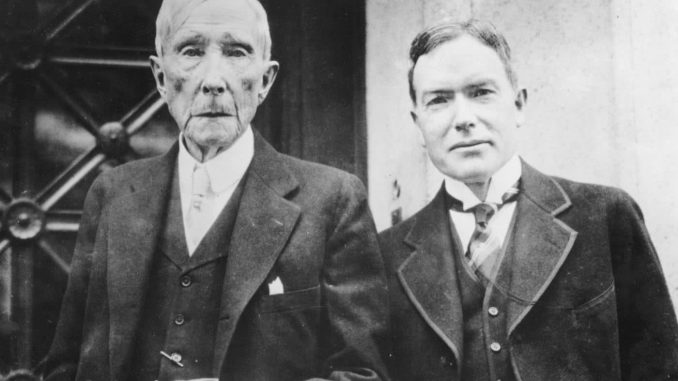Revelations by the late Dr. Richard L. Day in 1969 may have been shocking at the time, but not so much now as they have started coming true.
Dr. Day was an eminent physician, a professor of pediatrics at the Mount Sinai School of Medicine in Manhattan and Medical Director of the ‘Planned Parenthood’ organization.
He was also described as an ‘insider of the Order’ referring to the ‘Order of the Barbarians’ (as those involved in an elite group committed to the ‘New World Order’ were known as at the time), which are now referred to as the globalist elite.
During a closed lecture to other doctors in 1969, Dr. Day said the cure for cancer was on file at the Rockefeller Institute.
His audience was shocked when he told them: “We can cure almost every cancer right now. Information is on file in the Rockefeller Institute, if it’s ever decided that it should be released.”
The Dr. Richard Day Blog reports:
Dr. Dunegan recalls what Dr. Day said very clearly because he found it unbelievable (as did the other attendees) that an institute who could effectively treat one of the most destructive diseases known to humanity would withhold that knowledge.
Dr. Day continued “But consider – if people stop dying of cancer, how rapidly we would become overpopulated. You may as well die of cancer as something else.”
He then went on to explain that treatment would be geared more towards easing some of the symptoms and making the sufferer comfortable rather than a cure.
Although the Rockefeller Institute has taken precautions to hide the information within the institute, Dr. Day said that one day it may come to light if independent researchers get close to developing the same technology and cure. But for the time being, letting people die of cancer was a good thing because it would slow down the problem of overpopulation.
As with the attendees at the meeting, any normal thinking person may disbelieve that an organization which purports to research cures and new medical treatments would withhold this vital information. But as we have seen many times before, where there is power and money anything can happen, especially when the supporters of eugenics are involved.
So let’s take a look at the Rockefeller Institute.
The Rockefeller Institute (for Medical Research) changed its name to The Rockefeller University in 1965.
The institute was founded in 1901 by John D. Rockefeller, an American business magnate who was one of six children born to con artist/traveling salesman, William Avery “Bill” Rockefeller, and housewife Eliza Davison in Richford, New York in 1839.
Rockefeller made his fortune in the oil and petroleum industries through Standard Oil, eventually developing them to hold significant shares of the petroleum and oil markets in the U.S. until antitrust laws curtained their significant holdings.
At the time of his death in 1937 Rockefeller’s wealth made him the wealthiest person in recent history, far surpassing the fortune of Bill Gates.
The institute was the first biomedical institute in the United States and initially concentrated on biomedical engineering. It became the first institute for clinical research in the U.S. when it opened The Rockefeller Hospital on the campus in 1910.
Some of the scientific breakthroughs attributed to the institute are:
- blood groups and methods of preserving whole blood,
- invention of formula diets to precisely control the balance of nutrients in food,
- methadone maintenance therapy for people addicted to heroin,
- drug combinations that offered the first life-extending treatments for HIV infection and AIDS,
- the autoimmune nature of rheumatoid arthritis and psoriasis,
- and the first evidence that humans have natural immunity to tumors
The institute moved into the area of education in 1955 to expand its interests. It granted its first honors degree in 1959, and became the Rockefeller University in 1965, with many students since going on to gain influential positions in other universities, industry, and other fields.
Since the institution’s founding in 1901, 24 Nobel Prize winners have been associated with the university. Of these, two are Rockefeller graduates and five laureates are current members of the Rockefeller faculty.
At the time of writing, David Rockefeller (the oldest living member of the family at 99 years of age) is Honorary Chair of the University. After graduating from the University of Chicago in 1940, and a brief time as secretary, he joined the military at the outbreak of World War 2.
When he left at the end of the war, he joined his uncle’s company, Chase National Bank (primarily a wholesale bank), which is closely associated with the oil industry, especially what was to become Exxon Mobil.
In 1955 the bank moved more into retail banking, changing its name to Chase Manhattan Bank, which is now known as JPMorgan Chase. By 1969 Rockefeller had become chairman of the bank and continued until his retirement in 1981.
Chase Bank has been involved in many controversies in its various guises over the years, including the purchase of Nazi Germany’s Reich Marks and releasing funds to Nazi Germany during World War 2, and refusing to release funds belonging to Jews in occupied France. In more recent times, JPMorgan has been involved in the Enron scandal, guilty of speculative trading, and numerous others. It has been referred to as the ’most controversial bank’ by Forbes.
In 1973, Rockefeller founded the Trilateral Commission together with Zbigniew Brzezinski, as an independent body bringing prominent political and business figures together with the publicized aim of promoting political and economic dialogue across the world at a time of; considerable friction; among governments. The Commission is divided into three regional divisions, European, North American, and Asia Pacific.
The Commission has received considerable criticism since its inception. Most notably claims that the Commission is pivotal (in league with other organizations) in promoting and plotting to instill a world government system as part of a global push by influential organizations (such as major world financiers) towards a New World Order – ruled by a secret elite.
The Trilateral Commission also has very close ties with the Council on Foreign Relations, one of the oldest and most influential think tanks in the USA. There is also some crossover between the memberships of the two organizations. The Council on Foreign Relations’ David Rockefeller Studies Program’ is the hub of the think tank and employs 70 full-time ‘scholars’ and ‘practitioners’ who use their expertise and knowledge in covering issues affecting ‘today’s global agenda’.
As with the Trilateral Commission, the Council on Foreign Relations has been criticized for similar reasons – supporting globalism.
Both organizations have close ties to major corporations and many members are also senior executives. This has led to speculation that both organizations only represent the interests of large financial organizations and major global business, rather than their stated purposes.
It is important that we understand the relationship between the Rockefeller family and major financial and commercial interests, as well as their very close relationship with the world of politics. The Rockefeller University’s purpose could be to ensure ‘academics’ are placed in key positions within the global scientific community who are sympathetic to and will support, the motives of both the Trilateral Commission and the Council on Foreign Relations. These ‘academics’ and key business people could work together to present what seems to be a viable solution to world problems, but with the underlying intention of serving their own interests.
Cancer
Knowledge of cancer is speculated to go back as far as ancient Egyptian medical practice around 2500 B.C.
In more modern times, during the Renaissance, beginning in the 15th century, scientists developed a greater understanding of the human body. Scientists like Galileo and Newton began to use the scientific method, which later was used to study disease. Autopsies, done by Harvey (1628), led to an understanding of the circulation of blood through the heart and body that had until then been a mystery.
In 1761, Giovanni Morgagni of Padua was the first to do something which has become routine today – he did autopsies to relate the patient’s illness to pathologic findings after death. This laid the foundation for scientific oncology, the study of cancer.
The famous Scottish surgeon John Hunter (1728-1793) suggested that some cancers might be cured by surgery and described how the surgeon might decide which cancers to operate on. If the tumor had not invaded nearby tissue and was “moveable,” he said, “There is no impropriety in removing it.”
A century later the development of anesthesia allowed surgery to flourish and classic cancer operations such as the radical mastectomy were developed.
The 19th century saw the birth of scientific oncology with the use of the modern microscope in studying diseased tissues. Rudolf Virchow often called the founder of cellular pathology, provided the scientific basis for the modern pathologic study of cancer. As Morgagni had linked autopsy findings seen with the unaided eye with the clinical course of illness, so Virchow correlated microscopic pathology to illness.
This method not only allowed a better understanding of the damage cancer had done but also aided the development of cancer surgery. Body tissues removed by the surgeon could now be examined and a precise diagnosis could be made. The pathologist could also tell the surgeon whether the operation had completely removed the cancer.
Today, cancer treatments are still quite primitive, often relying on surgery to remove cancerous tissue in the hope that it has not already spread to other tissue. If it has, then this may result in further surgery, and so on.
Other treatments include radiotherapy usually using x-rays which, were discovered in 1895. In the region of 40% of people with cancer receive radiotherapy. As well as destroying the DNA of cancerous cells, the therapy also causes severe damage to healthy tissue. The theory is that normal tissues are more able to repair themselves than cancerous cells.
Chemotherapy uses a single cytotoxic drug or cocktail of drugs which are poisonous to cells. The aim is to kill off the cancer cells, but this also has the effect of killing healthy cells. One of the most common side effects is hair loss.
Despite cancer being known to more modern medical science for over 250 years, and the billions upon billions spent on research, there is no effective cure, and treatments still rely on old and highly damaging methods and a lot of hope. New and effective treatments seem to have made very little progress in the past century or so, and primarily involve tinkering with existing treatments.
The reality is that around 50% of people diagnosed with cancer will die from the disease. In the United States, the death rate from cancer has only been reduced by about 16% over a 20 year period – not a glowing statistic by any means. There has been less reduction in death from the disease in the UK.
Once of the biggest cancer charities in the UK is Cancer Research UK (registered charity 1089464) with a generated income for the last financial statement (2013-2014) of £537 million.
A charity which provides support to cancer patients is MacMillan Cancer Support (registered charity number 261017) with a generated income for the same period of £156 million.
In the United States, the American Cancer Society generated an income of $925 million according to the last available accounts to November 2013.
In addition to major charities, there are a number of national organizations in many countries, and in regions such as Europe, which also generate significant revenue from public and commercial sources. Cancer is very big business.
Drug companies are making huge profits from the sales of expensive targeted drug therapies. Sales of Xalkori (lung cancer) and Zelboraf (melanoma) account for around 46% of the estimated whopping $100 billion in cancer drug sales worldwide.
Rockefeller ‘cure’?
It is difficult to get information concerning a possible cure direct from Rockefeller University, which is understandable if Dr. Day’s statement incorrect – and there is no reason for it not to be.
The university is involved in cancer research through its Anderson Center for Cancer Research, which was established to encourage and support collaborations and approaches in developing treatment and researching cures. Cancer has been researched at the Rockefeller University (when it was an institute) since around 1911, and several milestones in cancer research have been attributed to Rockefeller scientists.
Since cancer has been researched in the relatively modern age, there have been many claims of ‘treatments’ said to cure cancer, and many claims that cures are being suppressed by large drug companies and other organizations (such as the Rockefeller Institute/University).
The claims have prompted many countries (including the U.S. and U.K.) to introduce legislation specifically designed to prevent claims of treatments which alleged to cure cancer which have not originated from standard scientific practices.
In one way the legislation can be seen as controlling claims made by manipulators and charlatans to protect vulnerable people, and on the other, it can be seen as suppressing any potential cure which does not originate from the standard medical practice and research.
Unfortunately, there are the more unscrupulous in society who will take advantage of people and promote ‘therapies’ or ‘remedies’ which will have little or no effect – with some causing health problems. The largely unregulated diet/slimming industry is a good example, where products have been sold based on dubious claims or references at an inflated price – effectively preying on the vulnerability of others.
On the other hand, a claim that something has the potential to cure cancer relies on the scientific community seeing initial credibility in the claim and conducting further research within established scientific testing models. The chances of something being researched by the scientific community are slim unless the source of the claim is already established within that community and it falls within the remit of their current research – which is often influenced by their financiers who may have other interests. These interests are often commercial, and unless there is potential profit in a claimed cure it is highly unlikely that any research will receive funding.
This effectively reduces the chances of anything which may be freely available to the population from being researched.
Again, we are moving into the corridors of power where profit dictates what will and will not be permitted at each stage of the process.
As with many other major scientific discoveries (especially in health science), it is ‘maverick’ scientists who bring about real change.
Casting aside the dogma and ‘rules’ imposed on them, the maverick scientist conducts real research and considers all possibilities while attempting to reach their goal.
A more recent example is that of UK researcher, Professor Gerry Potter.
In 2001, Potter hit the headlines with claims that he had discovered a drug that could rapidly kill cancer cells with no side effects. He claimed that the drug could almost eradicate cancerous cells within 24 hours and was 10,000 times more toxic to the cells than healthy ones (chemotherapy is at best only twice as toxic to cancerous cells as healthy ones). Potter made his discovery within two weeks of starting his research.
The drug, which could come in tablet form, only becomes toxic when it comes into contact with an enzyme found in cancer cells.
In laboratory tests, the drug destroyed 95% of cancer cells with the enzyme, including those of breast, colon, stomach, and brain cancer. Tumors resistant to other forms of treatment were also destroyed.
Potter predicted that it could take as long as a decade before the drug became available on the market because of the testing process for new drugs. In addition to clinical trials lasting many years, investors are sought so that the trials and further research can continue.
The results of these trials may also result in the drug being approved for some areas of treatment and not others.
Even when clinical trials are completed, it can take considerable time before a drug becomes available to those who would benefit from it, with cost to health authorities being the main deciding factor. Commercialization takes over.
The overly bureaucratic and dogmatic systems effectively inhibit effective treatments coming to market as each minor technicality is scrutinized by hordes of scientists and accountants.
This can place a potentially valuable treatment in limbo for many years.
As of today, access to effective cancer treatment is not available to every person who would potentially benefit from it, even though Potter’s discovery (which is one of many beneficial discoveries in the field of cancer research) was made in 2001.
The treatment of cancer is still based in very barbaric and ineffective treatments such as surgery and chemotherapy, with a survival rate at best of 50% of cancer sufferers. Chopping people up and blasting them with highly damaging and toxic chemicals is still considered to be acceptable when other less destructive methods could be available right now.
Taking the overall picture into account, it is highly likely that effective cancer treatments have been suppressed in the past. The reasons could be as simple as the lack of the scientific community of the period failing to take notice of new discoveries outside of their narrow perspectives, or the lack of financial interest in development. Rockefeller may be no different from many other organizations in this respect. Profit before doing what is best for the majority of the population.
Or maybe the lack of interest in curing the disease is part of a wider agenda to keep the earth’s population under control. To repeat what Dr. Day said, “But consider – if people stop dying of cancer, how rapidly we would become overpopulated. You may as well die of cancer as something else.”
Courtesy of The Revelations of Dr. Richard Day
*Article originally appeared at News Punch. Reposted with permission.












